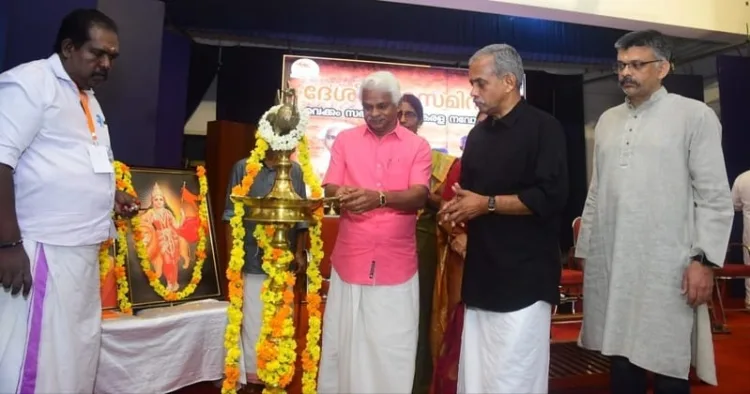“Organiser” Chief Editor Prafulla Ketkar said in Kottayam that the Vaikom Satyagraha empowered the freedom struggle at the national level. He was addressing a seminar organised on “National Renaissance and Vaikom Satyagraha” in connection with the Vaikom Satyagraha Centenary.
Organiser E Exit poll Lok Sabha Elections 2024
The Vaikom Satyagraha was known as the “Temple Entry Agitation.” Subsequently, T K Madhavan met Mahatma Gandhi and convinced him that the agitation was for the right to travel and walk. Accordingly, Mahatma Gandhi declared his support for the agitation. The Satyagraha at Vaikom aimed to unite Hindu society. During the same period, powerful agitations were going on in Maharashtra and Karnataka under the leadership of Swami Shradhananda and the Arya Samaj against casteism and inequalities. These movements grew and developed as supporting efforts for the freedom struggle. Activities against casteism spread throughout the country after the Vaikom Satyagraha drew national attention. Mahatma Gandhi held talks with Dr B R Ambedkar and Sree Narayana Guru several times in this regard.
Prafulla Ketkar opined that this is the occasion for us to reflect on whether we have achieved the final goal of the Vaikom Satyagraha. The Ram Janmabhoomi agitation, led by the Vishva Hindu Parishad, was another milestone in the history of the Hindu Renaissance. The shilanyas of the Sri Ram Mandir was performed by a so-called lower caste Hindu, upholding the ideal that Hindus are one and that there are no ‘lower’ members in the Hindu community. Such activities are the right of every Hindu. The protection of the temple is the right of every Hindu, and anti-Hindu elements should quit the temple administration.
Hindu Aikya Vedi organised seminar on May 24 at Vaikkom.
J Nandakumar, senior RSS Pracharak and national co-ordinator of Prajna Pravah said on the occasion that Vaikkom Satyagraha was not only a 20-month agitation programme, but it carries an inevitable future. The gradual evolution of the Hindu Renaissance started to take shape several centuries before. He said this while inaugurating the “Vaikom Satyagraha and Kerala Renaissance” seminar. Renaissance is not a novel concept for Bharat. Bharat is the land of renaissance. Renaissance is the path that leads us in the right direction when society slips to the wrong path of adharma. Some people are trying to convert the Vaikom Satyagraha Centenary celebrations to an opportunity for Cutting South. The advocates of cutting South aim to eradicate Sanadhan Dharma. They take this opportunity to misguide the posterity by creating a narrative that southern states do not belong to Bharat. They create new narratives to misguide the future generation that E V Ramaswamy Naicker liberated Keralites from casteism.
J Nandakumar said that we do not need a centenary celebration by rejecting Vaikom Satyagraha’s real identity or forgetting the great souls who sacrificed their lives for it. We should go ahead by remembering them and accepting their messages as the focal points. Vaikom Satyagraha is the symbol of social unity, social consensus, and Hindu unity.
J Nandakumar added that what we see in the discussions on novel renaissance is the rejection of luminaries of Satyagraha, and they reject the Hindu renaissance as the goal of Vaikom Satyagraha. T K Madhavan was the backbone of Vaikkom Satyagraha. Prominent personalities from various castes played their roles in leading it. T K Madhavan said that Vaikom Satyagraha was for the renaissance of Hindu Dharma. J Nandakumar quoted his statement that he did not wait for anybody’s certificate that he was a Hindu. He considered it was his birthright to be a Hindu. He grasped the basics of Hindu Dharma from Harinama Keerthana and Swami Vivekananda’s philosophies. Pandit Karuppan Master criticised the evils of casteism through his poems like Jaathikkummi. Sankaracharya stated that caste-based superiority is the first evil to be shed to attain spiritual realisation.
Justice (Retd.) C N Ramachandran Nair chaired. He said that Vaikom Satyagraha was an agitation for equality. But it is doubtful if we have achieved the goal. We have miles to go. Citizenship is important for foreigners. We are ‘Bharatiya’, our most important concept. Some people are reluctant to move to that thought process. Justice Ramachandran Nair said that such a tendency should go.
N Gangadharan, the grandson of T K Madhavan, delivered the Vaikom Satyagraha memorial speech. Gangadharan and Vinod Chandran, the grandson of Mannath Padmanabhan, were also honoured during the occasion.
Bharatiya Vichara Kendram Director R Sanjayan spoke on “Social Unity and Vaikom Satyagraha”. Karnataka music maestro Mathangi Satyamoorthy rendered the prayer song.
N. Gangadharan released the book “Hindutva Puthiya Kaalam” (a Malayalam translation of “Hindutva for the Changing Times”) by presenting a copy to N Gangadharan.
E S Biju, the spokesman of Hindu Aikya Vedi, read out the Vaikom Satyagraha oath. N U Sanjay rendered the unity song. Hindu Aikya Vedi state president K P Sasikala teacher participated in the programme. Hindu Aikya Vedi spokesman R V Babu welcomed the gathering, and organising committee general convener, M.V. Unnikrishnan proposed a vote of thanks.



















Comments